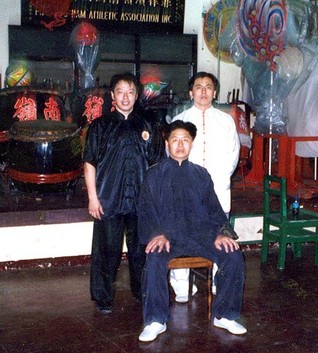Interview with Arnold Buenviaje
|
In the early years of venturing out into the online martial arts community I found few people whose experiences closely matched my own. In those days, practitioners of Lin Jingshan’s line of Tanglang outside of China were few and far between and my understanding of other families of Mantis Boxing was restricted due to limited exposure. Arnold Buenviaje (Cai Mingren) of the Philippine Ming Sheng Wushu Association, Philippine Chi Ching Wushu Association and disciple of Master Zhong Lianbao, spoke in terminology I understood and trained in essentially the same methods. Through extensive and generous sharing, Arnold’s knowledge of both the Tanglang of Lin Jingshan and also that of the greater Tanglang Men helped me to better understand my own.
|
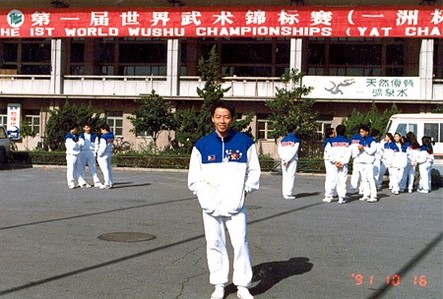 The First World Wushu Championships in Beijing
The First World Wushu Championships in Beijing
BT: Thanks for agreeing to speak with me Buenviaje Shifu. Could you please give us a bit of personal background? I believe it’s useless to look purely at the ‘product’ without any knowledge of the source.
AB: I was born in Manila 1962, my father was a Chinese immigrant and my mother was a Chinese mestiza (half Chinese half Filipina). I came from a middle-income family. There are 5 brothers and sisters; I am second from the eldest. I was educated at Saint Stephen’s High School, a Chinese school in Manila and I graduated with a Bachelor of Science in Architecture from the University of Santo Tomas. Because of family business, I was not able to pursue a housing design career. I run a construction supply business and I currently live in Manila, in the Chinatown area.
Where in China is your father from?
My father came from Quan Feng village, Jinjiang, Fujian, China.
You have been training for most of your life right – Beginning in the 70's?
I started Wushu training in 1977 at Ling Nam Athletic Association (Ling Nam changed its status to federation in the later years), then in 1988 Ling Nam sent me to Wushu Federation Philippines to undergo Contemporary Wushu training. Later I became a member of the Philippine National Wushu Team. I trained with different Chinese coaches namely Li Junfeng, Chen Guorung, Mo Shaoneng and Ms. Mi Jinbei.
From 1991 I returned to Ling Nam to help out and teach there. In 1993 I became disciple of Shifu Zhong Lianbao. In 1995 I began teaching at Chi Ching Wushu Association, the same year I became the disciple of Tibetan White Crane master Luk Chung Mow. By 2002 I left Ling Nam as an Assistant Chief Instructor. In 2006, together with my students I established Ming Sheng Wushu Association and I am teaching and sending my students to teach Wushu at the downtown YMCA since 2000.
In recent years I also furthered studies in Tibetan White Crane with Shifu Yau Yuk Kong of Hong Kong. Last year I organized the Philippine Dragon and Lion Dance Union. This 2011 we have established the International Qixing Tanglang Kung Fu Federation Philippines, an affiliate branch of International Qixing Tanglang Kung Fu Federation of Yantai.
That’s certainly a very packed martial career, with no signs of slowing down it seems!
AB: I was born in Manila 1962, my father was a Chinese immigrant and my mother was a Chinese mestiza (half Chinese half Filipina). I came from a middle-income family. There are 5 brothers and sisters; I am second from the eldest. I was educated at Saint Stephen’s High School, a Chinese school in Manila and I graduated with a Bachelor of Science in Architecture from the University of Santo Tomas. Because of family business, I was not able to pursue a housing design career. I run a construction supply business and I currently live in Manila, in the Chinatown area.
Where in China is your father from?
My father came from Quan Feng village, Jinjiang, Fujian, China.
You have been training for most of your life right – Beginning in the 70's?
I started Wushu training in 1977 at Ling Nam Athletic Association (Ling Nam changed its status to federation in the later years), then in 1988 Ling Nam sent me to Wushu Federation Philippines to undergo Contemporary Wushu training. Later I became a member of the Philippine National Wushu Team. I trained with different Chinese coaches namely Li Junfeng, Chen Guorung, Mo Shaoneng and Ms. Mi Jinbei.
From 1991 I returned to Ling Nam to help out and teach there. In 1993 I became disciple of Shifu Zhong Lianbao. In 1995 I began teaching at Chi Ching Wushu Association, the same year I became the disciple of Tibetan White Crane master Luk Chung Mow. By 2002 I left Ling Nam as an Assistant Chief Instructor. In 2006, together with my students I established Ming Sheng Wushu Association and I am teaching and sending my students to teach Wushu at the downtown YMCA since 2000.
In recent years I also furthered studies in Tibetan White Crane with Shifu Yau Yuk Kong of Hong Kong. Last year I organized the Philippine Dragon and Lion Dance Union. This 2011 we have established the International Qixing Tanglang Kung Fu Federation Philippines, an affiliate branch of International Qixing Tanglang Kung Fu Federation of Yantai.
That’s certainly a very packed martial career, with no signs of slowing down it seems!
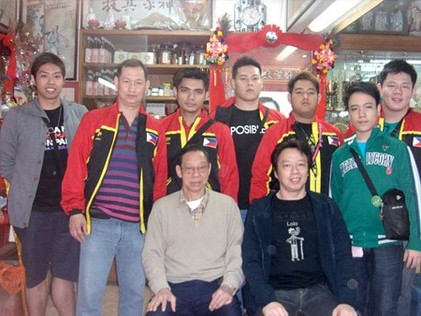 Arnold and students with Shifu Luk Chung Mow in Hong Kong
Arnold and students with Shifu Luk Chung Mow in Hong Kong
Manila’s Ling Nam Athletic Federation where you commenced your training sounds like one of the classical Chinese physical cultivation associations such as the Jingwu Hui.
Ling Nam was a Cantonese association, it was founded in 1958 by Choy Gar master Zhang Jingshan, his assistant was a Fut Gar master Yu Xinfu. Aside from them, there were some masters who taught there such as Old Hung Gar style specialist Liu Jin (Lao Kim) and later Shakespeare Chan who taught Hung Gar, Qixing Tanglang and Tibetan White Crane. These masters have taught for some period of time at Ling Nam. In recent years, Ling Nam has occasionally invited Qixing Tanglang Shifu Zhong Lianbao, Tibetan White Crane Luk Chung Mow and Cheung Kwok Wah of Hong Kong to teach. So Ling Nam was a melting pot of different styles.
I can only imagine having access to such a diverse range of styles and masters as a youngster. It’s no wonder you were hooked on martial arts so strongly.
Was this organisation mainly involved in the instruction of ethnic Chinese?
Yes, they only accept Chinese and mestizo (Half Chinese and half Filipino) during the early times, but as time passed, they now accept Filipinos as well.
At the Federation I believe you were exposed to a wide range of systems, including The Qixing Tanglang of Luo Guangyu. What were those other styles and which, if any, have you continued to train and teach?
While in Ling Nam I studied Luo Guang Yu’s Qixing Tanglang, Choy Gar, 12 routes of Tam Tui, Lee Gar, Tibetan White Crane and Hung Gar. After leaving Ling Nam, I was lucky to further my study of White Crane with Yau Yuk Kong. I now mainly propagate Zhong Lianbao’s style of Qixing Tanglang. I sometimes teach Hung Gar and White Crane to my older students that want to cross train.
How did Tibetan White Crane make its way to the Philippines? The Fujian varieties seem much more common in other parts of South East Asia, probably mainly due to the migration of large numbers of Hokkien people to the region.
There is no Fujian White Crane style in the Philippines but only Wuzhu Quan or Five Ancestor fist. The Tibetan White Crane was first introduced by Shakespeare Chan. Chan learned it from Ou Hai, a student of Luk Chi Fu of Hong Kong. In the 70’s Ling Nam ask Shifu Chan to teach at Ling Nam. Now there are 5 lineages of Tibetan White Crane in the Philippines, the Ou Hai, Ngai Yuk Tong (disciple of Kwong Boon Fu), Luk Chung Mow (son of Luk Chi Fu), Cheung Kwok Wah and Yau Yuk Kong (disciple of Tang Chek Ming).
Ling Nam was a Cantonese association, it was founded in 1958 by Choy Gar master Zhang Jingshan, his assistant was a Fut Gar master Yu Xinfu. Aside from them, there were some masters who taught there such as Old Hung Gar style specialist Liu Jin (Lao Kim) and later Shakespeare Chan who taught Hung Gar, Qixing Tanglang and Tibetan White Crane. These masters have taught for some period of time at Ling Nam. In recent years, Ling Nam has occasionally invited Qixing Tanglang Shifu Zhong Lianbao, Tibetan White Crane Luk Chung Mow and Cheung Kwok Wah of Hong Kong to teach. So Ling Nam was a melting pot of different styles.
I can only imagine having access to such a diverse range of styles and masters as a youngster. It’s no wonder you were hooked on martial arts so strongly.
Was this organisation mainly involved in the instruction of ethnic Chinese?
Yes, they only accept Chinese and mestizo (Half Chinese and half Filipino) during the early times, but as time passed, they now accept Filipinos as well.
At the Federation I believe you were exposed to a wide range of systems, including The Qixing Tanglang of Luo Guangyu. What were those other styles and which, if any, have you continued to train and teach?
While in Ling Nam I studied Luo Guang Yu’s Qixing Tanglang, Choy Gar, 12 routes of Tam Tui, Lee Gar, Tibetan White Crane and Hung Gar. After leaving Ling Nam, I was lucky to further my study of White Crane with Yau Yuk Kong. I now mainly propagate Zhong Lianbao’s style of Qixing Tanglang. I sometimes teach Hung Gar and White Crane to my older students that want to cross train.
How did Tibetan White Crane make its way to the Philippines? The Fujian varieties seem much more common in other parts of South East Asia, probably mainly due to the migration of large numbers of Hokkien people to the region.
There is no Fujian White Crane style in the Philippines but only Wuzhu Quan or Five Ancestor fist. The Tibetan White Crane was first introduced by Shakespeare Chan. Chan learned it from Ou Hai, a student of Luk Chi Fu of Hong Kong. In the 70’s Ling Nam ask Shifu Chan to teach at Ling Nam. Now there are 5 lineages of Tibetan White Crane in the Philippines, the Ou Hai, Ngai Yuk Tong (disciple of Kwong Boon Fu), Luk Chung Mow (son of Luk Chi Fu), Cheung Kwok Wah and Yau Yuk Kong (disciple of Tang Chek Ming).
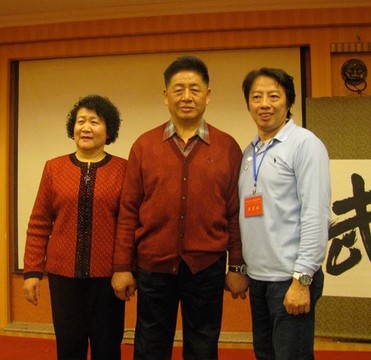 With Shimu and Shifu Zhong Lianbao at his birthday celebration
With Shimu and Shifu Zhong Lianbao at his birthday celebration
When and how was Tanglang brought to the Philippines? What lineages exist there today?
The Luo Guangyu Tanglang was brought by Shakespeare Chan, he learn it from Chiu Chi Man. He taught at Ling Nam in the 1970’s and later opened his own school called Jing Wu, but closed down after a few years. There is also Liang Ji Ci who moved to the Philippines, where he taught Tanglang. His Tanglang came from different Taiwan masters like Liuhe Tanglang Zhang Xiang Shan, Babu Tanglang Wei Xiao Tang, Taiji Tanglang Liu Zu Yuan and Qixing Tanglang Wang Song Ting, he is also the son in law of Han Qing Tan. He established the Jiann Shyong Kung Fu Center, he returned to the States in the mid 80’s. In 1993 the Qixing Tanglang style of Shifu Zhong Lianbao was introduced.
It is safe to say that you are most widely known as a master of Tanglang Quan. Having such a diverse background in Chinese martial arts, what was it about Mantis Boxing made it the right fit for you?
I think the speed and the power behind every technique.
You’ve had an extensive and successful career in all aspects of martial art competition, spanning two decades, representing your country at several international championships. Most interestingly, you competed in an international Kuoshu Tournament in Taiwan in the early 80’s. Did you fight leitai in that particular competition?
The Taiwan competition was a leitai competition. Before the competition we trained for 6 months. Every night we fought with at least 4-5 guys a night. A night before we flew to Taiwan, my parents came to the gym to talk to the instructor, they told him that if anything happens to me he will be held responsible. I was mad with my parents (later I realized that they are just protecting me). I wanted to fight, so the instructor said let see what happens. When we reached the competition, there was no protective armour shield for the body and gloves that looked like a hand brace. Whenever you punch, your knuckle would come of the so-called gloves. After discussion the instructor order me to sit it out because of the danger with no protection.
It’s unfortunate, but I can understand his concern and he was probably also worried about facing your parents on your return - especially if you had a broken jaw or missing eye.
Some of my team mates slugged it out but didn’t win. There were 3 ambulances going back and forth from the hospital.
I’ve heard that the Taiwanese Leitai competitions were amongst the roughest in the modern era. I like that though. Maybe not so smart from a longevity or health perspective, but certainly in keeping with the spirit of traditional Chinese Boxing.
Was full contact fight training a part of the Ling Nam curriculum?
In my time at Ling Nam we did a lot of sparring, we put on gloves and armour when we would do all out, but now they don’t do sparring anymore, only forms or taolu. For my school we still do sparring for the older students.
Did anyone from Ling Nam compete in the South East Asian full-contact championships of the late 60’s - early 80’s? From all accounts, these were also fairly wild events.
I think we were the only team Ling Nam had ever sent to a full-contact tourney.
The Luo Guangyu Tanglang was brought by Shakespeare Chan, he learn it from Chiu Chi Man. He taught at Ling Nam in the 1970’s and later opened his own school called Jing Wu, but closed down after a few years. There is also Liang Ji Ci who moved to the Philippines, where he taught Tanglang. His Tanglang came from different Taiwan masters like Liuhe Tanglang Zhang Xiang Shan, Babu Tanglang Wei Xiao Tang, Taiji Tanglang Liu Zu Yuan and Qixing Tanglang Wang Song Ting, he is also the son in law of Han Qing Tan. He established the Jiann Shyong Kung Fu Center, he returned to the States in the mid 80’s. In 1993 the Qixing Tanglang style of Shifu Zhong Lianbao was introduced.
It is safe to say that you are most widely known as a master of Tanglang Quan. Having such a diverse background in Chinese martial arts, what was it about Mantis Boxing made it the right fit for you?
I think the speed and the power behind every technique.
You’ve had an extensive and successful career in all aspects of martial art competition, spanning two decades, representing your country at several international championships. Most interestingly, you competed in an international Kuoshu Tournament in Taiwan in the early 80’s. Did you fight leitai in that particular competition?
The Taiwan competition was a leitai competition. Before the competition we trained for 6 months. Every night we fought with at least 4-5 guys a night. A night before we flew to Taiwan, my parents came to the gym to talk to the instructor, they told him that if anything happens to me he will be held responsible. I was mad with my parents (later I realized that they are just protecting me). I wanted to fight, so the instructor said let see what happens. When we reached the competition, there was no protective armour shield for the body and gloves that looked like a hand brace. Whenever you punch, your knuckle would come of the so-called gloves. After discussion the instructor order me to sit it out because of the danger with no protection.
It’s unfortunate, but I can understand his concern and he was probably also worried about facing your parents on your return - especially if you had a broken jaw or missing eye.
Some of my team mates slugged it out but didn’t win. There were 3 ambulances going back and forth from the hospital.
I’ve heard that the Taiwanese Leitai competitions were amongst the roughest in the modern era. I like that though. Maybe not so smart from a longevity or health perspective, but certainly in keeping with the spirit of traditional Chinese Boxing.
Was full contact fight training a part of the Ling Nam curriculum?
In my time at Ling Nam we did a lot of sparring, we put on gloves and armour when we would do all out, but now they don’t do sparring anymore, only forms or taolu. For my school we still do sparring for the older students.
Did anyone from Ling Nam compete in the South East Asian full-contact championships of the late 60’s - early 80’s? From all accounts, these were also fairly wild events.
I think we were the only team Ling Nam had ever sent to a full-contact tourney.
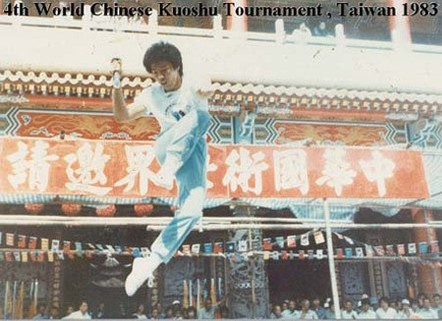
Although a master of chuantong (traditional) wushu, are you also involved to any extent in the development of modern or sports wushu in your country? If so, what do you see as the merits of sport wushu and are there any positives traditional wushu can adopt from its modern counterpart?
I am not a coach for Contemporary Wushu, only Traditional Wushu. Last March, Wushu Federation Philippines asked us to represent the Philippines National Team during a Wushu competition in Hong Kong. All athletes that were sent were my students and they competed in the traditional Wushu taolu event.
The training I undertook in 1988 for Contemporary Wushu, helped me to adopt some athletic training that I incorporated into my traditional Wushu training program -flexibility, some kicking exercises, speed training, improving stances etc.
Would you agree that certain elements of sports wushu training are potentially destructive to the athlete’s body? There seems to be a high incidence of fairly severe joint and ligament injuries, particularly in the knees and ankles. Also the peak of an athlete’s career is quite short. Of course traditional wushu practice also has its fair share of negative physical effects.
Yes, I agree because the taolu of modern Wushu requires the attainment of greater height in jumping. Sometimes the difficulty of movements becomes exceedingly greater and injuries tend to happen. Occasionally these injuries become career threatening. On the traditional Wushu side the injuries are less, but of course if you do Leitai competition and duilian (partnered sparring routines) it can be the same for both Modern and traditional. You can have injuries such as dislocations, broken ribs, broken hand etc.
What are some of the injuries you have sustained in your training?
The worst I got from modern Wushu was a bad knee. I had to have a knee support for a couple of months. I got this from practicing Nanquan. From traditional, I broke my left hand during duilian - 3 sectional staff versus a pair of tonfa. I underwent surgery and wore a steel brace for 6 months.
Were you hit with the 3 section staff or the tonfa? Both could be pretty nasty but I think I’d prefer not to get hit with the 3 section (though I have already smashed myself in the head a few times). My teacher had his front tooth broken with a 3 section staff during a performance for international dignitaries, so he couldn’t stop or show pain until he was out of sight.
My hand was hit with the tonfa. It was painful but I finished the duilian. After I finished the duilian, I had it massaged by my team mates (I thought it was nothing), then my hand was swollen, but I still had 2 more duilian to go, so I wrapped a bandage and continued the exhibition. It took me a couple of days to found out that I broke my hand.
Aaah, nothing like a nice bit of massage on a broken bone, ha ha...
I am not a coach for Contemporary Wushu, only Traditional Wushu. Last March, Wushu Federation Philippines asked us to represent the Philippines National Team during a Wushu competition in Hong Kong. All athletes that were sent were my students and they competed in the traditional Wushu taolu event.
The training I undertook in 1988 for Contemporary Wushu, helped me to adopt some athletic training that I incorporated into my traditional Wushu training program -flexibility, some kicking exercises, speed training, improving stances etc.
Would you agree that certain elements of sports wushu training are potentially destructive to the athlete’s body? There seems to be a high incidence of fairly severe joint and ligament injuries, particularly in the knees and ankles. Also the peak of an athlete’s career is quite short. Of course traditional wushu practice also has its fair share of negative physical effects.
Yes, I agree because the taolu of modern Wushu requires the attainment of greater height in jumping. Sometimes the difficulty of movements becomes exceedingly greater and injuries tend to happen. Occasionally these injuries become career threatening. On the traditional Wushu side the injuries are less, but of course if you do Leitai competition and duilian (partnered sparring routines) it can be the same for both Modern and traditional. You can have injuries such as dislocations, broken ribs, broken hand etc.
What are some of the injuries you have sustained in your training?
The worst I got from modern Wushu was a bad knee. I had to have a knee support for a couple of months. I got this from practicing Nanquan. From traditional, I broke my left hand during duilian - 3 sectional staff versus a pair of tonfa. I underwent surgery and wore a steel brace for 6 months.
Were you hit with the 3 section staff or the tonfa? Both could be pretty nasty but I think I’d prefer not to get hit with the 3 section (though I have already smashed myself in the head a few times). My teacher had his front tooth broken with a 3 section staff during a performance for international dignitaries, so he couldn’t stop or show pain until he was out of sight.
My hand was hit with the tonfa. It was painful but I finished the duilian. After I finished the duilian, I had it massaged by my team mates (I thought it was nothing), then my hand was swollen, but I still had 2 more duilian to go, so I wrapped a bandage and continued the exhibition. It took me a couple of days to found out that I broke my hand.
Aaah, nothing like a nice bit of massage on a broken bone, ha ha...
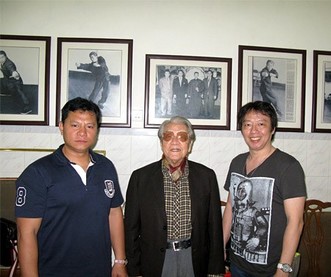 With Shifu Yak Yuk Kong and Shifu Chan Hak Fu
With Shifu Yak Yuk Kong and Shifu Chan Hak Fu
What is your opinion about combat sports? Which, if any kind, do you think is the most compatible for Mantis Boxing?
I think all martial art styles are good, it depends on the practitioner to make it effective. Mantis Boxing would probably be a cross between kick boxing and aikido.
Interesting analysis! So with that in mind, do you think it’s best for us to compete in Sanda, Muay Thai, kickboxing or MMA?
I think we can make it good with Sanda or kickboxing.
What fight-specific training methods do you employ? At what stage of an individuals training do you introduce them?
I train them in sparring, technique application, kicking and punching pads, sandbag, exercises such as toughening the stomach, arms etc. I let my older students do defensive sparring, technical sparring then free style sparring.
Clearly combat oriented Tanglang. Your students are lucky to have the full spectrum available to them. What about iron palm and body tempering methods? Do you teach them to your current students? Do you also utilise traditional medicine in this regard?
I do slapping palm and thrusting fingers on the concrete wall. I do baton hitting on the shin and forearm. We also do Tie Shen Kao Da (Leaning Body Conditioning), it is a 2 person routine that strikes to the chest, stomach, forearm, buttock and shin. We also do forearm striking. We use traditional Dit Dat liniment before and after practising. A friend of my mine makes the liniment.
What are the dimensions and material of the baton? Does that Kao Da drill consist of eight variations?
Actually it’s a round wooden stick, 2 inches in diameter and the length is about 16 inches. Yes there are eight variations.
You connected with Master Zhong Lianbao, disciple of the late GM Lin Jingshan fairly early in the 90’s. How did you end up in Yantai training under Zhong Shifu?
In 1993 Ling Nam was competing in Yantai. There were seven of us and I was designated to attend an athlete/coaches meeting. There I met Wang Liguo (a senior student of Zhong Lianbao). We began talking and when I popped up the question of who was his Shifu, he said Zhong Lianbao. I felt his name sounded familiar. At that time I brought a Qixing Tanglang lineage chart with me, and I saw him named under Lin Jingshan. I was excited to meet Wang’s Shifu, and then we were introduced. After a few conversations we asked if he could instruct us and he was kind enough to teach a few techniques. The next day we were at his house practising.
If you had not thought to bring the lineage chart you may never have even met.
What was your first impression of training in Yantai?
We practised in a driveway and a park. Most of the time I was with Shifu he showed me the application of techniques. He taught me tripping methods and circular movement. One time we trained in the evening, we finished past 12 midnight. His nephews including Zhong Xiang, Zhong Ziping and Zhong Qiyong were the ones in charge with the taolu. The training was personalized.
What struck you as the stand out difference between Yantai Qixing and the Mantis Boxing you had already trained for years?
I feel the Yantai Qixing, or more specifically, Shifu Zhong’s Tanglang, is more free-flowing. The movements are simpler, yet more effective.
Did you meet and train with any other masters in Yantai?
Yes in Yantai, I studied with Yu Tiancheng, during that time Shifu Slawomir Milczarek was one of my classmates then. Actually it was a seminar - I learned Rou Ling Quan and Fan Che Quan
This version of Rou Ling is very difficult in my opinion. It contains a lot of complex hand skills.
Yes Rou Ling has many complex hand skills. Shifu Yu Tiancheng was a good teacher.
I think all martial art styles are good, it depends on the practitioner to make it effective. Mantis Boxing would probably be a cross between kick boxing and aikido.
Interesting analysis! So with that in mind, do you think it’s best for us to compete in Sanda, Muay Thai, kickboxing or MMA?
I think we can make it good with Sanda or kickboxing.
What fight-specific training methods do you employ? At what stage of an individuals training do you introduce them?
I train them in sparring, technique application, kicking and punching pads, sandbag, exercises such as toughening the stomach, arms etc. I let my older students do defensive sparring, technical sparring then free style sparring.
Clearly combat oriented Tanglang. Your students are lucky to have the full spectrum available to them. What about iron palm and body tempering methods? Do you teach them to your current students? Do you also utilise traditional medicine in this regard?
I do slapping palm and thrusting fingers on the concrete wall. I do baton hitting on the shin and forearm. We also do Tie Shen Kao Da (Leaning Body Conditioning), it is a 2 person routine that strikes to the chest, stomach, forearm, buttock and shin. We also do forearm striking. We use traditional Dit Dat liniment before and after practising. A friend of my mine makes the liniment.
What are the dimensions and material of the baton? Does that Kao Da drill consist of eight variations?
Actually it’s a round wooden stick, 2 inches in diameter and the length is about 16 inches. Yes there are eight variations.
You connected with Master Zhong Lianbao, disciple of the late GM Lin Jingshan fairly early in the 90’s. How did you end up in Yantai training under Zhong Shifu?
In 1993 Ling Nam was competing in Yantai. There were seven of us and I was designated to attend an athlete/coaches meeting. There I met Wang Liguo (a senior student of Zhong Lianbao). We began talking and when I popped up the question of who was his Shifu, he said Zhong Lianbao. I felt his name sounded familiar. At that time I brought a Qixing Tanglang lineage chart with me, and I saw him named under Lin Jingshan. I was excited to meet Wang’s Shifu, and then we were introduced. After a few conversations we asked if he could instruct us and he was kind enough to teach a few techniques. The next day we were at his house practising.
If you had not thought to bring the lineage chart you may never have even met.
What was your first impression of training in Yantai?
We practised in a driveway and a park. Most of the time I was with Shifu he showed me the application of techniques. He taught me tripping methods and circular movement. One time we trained in the evening, we finished past 12 midnight. His nephews including Zhong Xiang, Zhong Ziping and Zhong Qiyong were the ones in charge with the taolu. The training was personalized.
What struck you as the stand out difference between Yantai Qixing and the Mantis Boxing you had already trained for years?
I feel the Yantai Qixing, or more specifically, Shifu Zhong’s Tanglang, is more free-flowing. The movements are simpler, yet more effective.
Did you meet and train with any other masters in Yantai?
Yes in Yantai, I studied with Yu Tiancheng, during that time Shifu Slawomir Milczarek was one of my classmates then. Actually it was a seminar - I learned Rou Ling Quan and Fan Che Quan
This version of Rou Ling is very difficult in my opinion. It contains a lot of complex hand skills.
Yes Rou Ling has many complex hand skills. Shifu Yu Tiancheng was a good teacher.
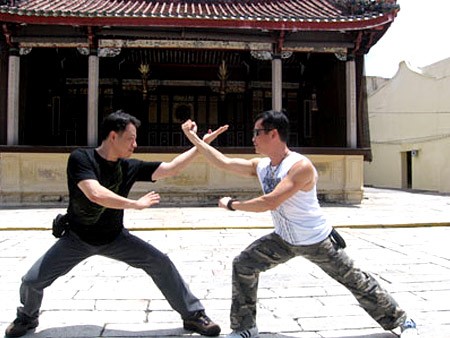
I believe you and your brothers were Zhong Lianbao’s first international disciples. Can you outline the circumstances that lead to you undergoing baishi (discipleship ceremony) with Zhong Shifu? Had you taken such vows in the past in the Philippines?
We had been training with Shifu Zhong for 2 to three days in Yantai. Shifu Zhong is a quiet man, a man of a few words. He trained me most of the time and I felt a special relationship with him. I thought it would be great if he would become our Shifu so I discussed with my other Wushu brothers about it and they agreed to my proposal. We talked to Shifu Zhong about the baishi but he was reluctant in accepting us, for we were just foreigner who came to learn Wushu just for only a couple of days. Then I talked to Zhong Jian (Shifu Zhong‘s daughter) to convince her father to accept us. With the persistence of Zhong Jian, the four of us were finally accepted.
During my time in Ling Nam there were no Shifu, only instructors. So everyone is called by first name, even the most senior instructor was called by his alias. Only in recent years did they change that among the younger students at Ling Nam. We never had baishi prior to Shifu Zhong’s baishi.
No doubt you have special place in your heart for Zhong Jian after her good work.
Yes, I owe it to her. She once came to the Philippines with Shifu Zhong and Shimu.
You’ve also been lucky enough to have your teacher visit your country on a few occasions as well. Was he able to witness any of the local martial arts during those trips? If so, what was his assessment?
Shifu Zhong visited the Philippines four or five times in the past. But he didn’t give his opinion regarding other style of martial arts.
We had been training with Shifu Zhong for 2 to three days in Yantai. Shifu Zhong is a quiet man, a man of a few words. He trained me most of the time and I felt a special relationship with him. I thought it would be great if he would become our Shifu so I discussed with my other Wushu brothers about it and they agreed to my proposal. We talked to Shifu Zhong about the baishi but he was reluctant in accepting us, for we were just foreigner who came to learn Wushu just for only a couple of days. Then I talked to Zhong Jian (Shifu Zhong‘s daughter) to convince her father to accept us. With the persistence of Zhong Jian, the four of us were finally accepted.
During my time in Ling Nam there were no Shifu, only instructors. So everyone is called by first name, even the most senior instructor was called by his alias. Only in recent years did they change that among the younger students at Ling Nam. We never had baishi prior to Shifu Zhong’s baishi.
No doubt you have special place in your heart for Zhong Jian after her good work.
Yes, I owe it to her. She once came to the Philippines with Shifu Zhong and Shimu.
You’ve also been lucky enough to have your teacher visit your country on a few occasions as well. Was he able to witness any of the local martial arts during those trips? If so, what was his assessment?
Shifu Zhong visited the Philippines four or five times in the past. But he didn’t give his opinion regarding other style of martial arts.
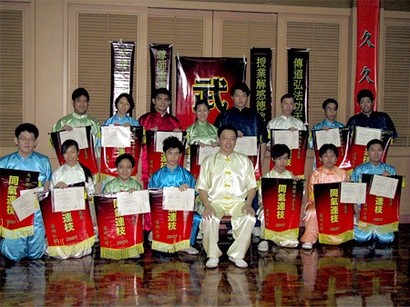
As an outsider, when I think of Zhong Lianbao’s trademark skill, I think of qinna. Of all of Lin Jingshan’s descendants, he is evidently the specialist in the art of locking and seizing. He is a large man with big fists, certainly well armed for the striking aspect of Tanglang, yet he seems to be most in his element controlling and destabilising an opponent. I have heard that Zhong Lianbao may have often trained inside with Lin Jingshan. Perhaps that kind of environment lent itself to the practice of qinna?
Shifu Zhong and Yu Hai trained together with Lin Jingshan when he was in his advanced years, When the Cultural Revolution came martial arts were banned. They would usually go to Lin Jingshan’s house to train secretly.
This is what I was also told.
When Yu Hai and Shifu Zhong grew bigger, Lin Jingshan asked them join the new Modern Wushu which was promulgated by the government. The reason why Lin Jingshan asked them to join Modern Wushu was because of frustration over the banning of the traditional martial arts. But Shifu Zhong continued to study with Lin Jingshan. As years went by life became harder, Lin Jingshan later got sick. Shifu Zhong was married and had a kid. Shifu Zhong was working in a factory, his salary was little but he would give money to Lin Jingshan who was old and alone at home. It was during this time that Lin Jingshan further taught Shifu Zhong.
So were the qinna skills learnt mainly in these later years or during the period of the Cultural Revolution?
Shifu never told me when he learned that. What is amazing is that all these years I have known my Shifu; I felt that he his qinna has become more and more skilful.
There are also a couple of other unique markers in Zhong Lianbao’s Tanglang. One is the Qixing Bu. In Yantai Qixing the front leg is always bent in this posture, yet it seems bent to a much greater degree and also seems to support more weight on the front leg in Zhong’s Tanglang. As a result, weight looks more evenly distributed between both legs and the toes of the front foot do not seem as raised. What is the application?
The Qixing Bu you mention is the Qixing Bu Zai Chui (Seven Star Step Descending Punch) posture. The Qixing Bu used in this posture is to stamp the foot of your opponent using the front foot, and your punching hand is positioned that way for further reach. Shifu Zhong told me it was Lin Jingshan’s revision later in his teaching career.
In common with some Dongbei and Qingdao Qixing, Master Zhong also seems to favour the ban ma (half horse) or siliu bu (4/6 stance) over xu bu (empty stance) or kuahu bu (riding tiger), particularly in Tanglang Shuang Feng Shou (Mantis Double Sealing Hand). I have noticed this becoming more common throughout Shandong Tanglang and have also been told by some that in earlier times there was no xu bu. What are your thoughts on this?
I remember Shifu Zhong told me that Lin Jingshan change to movement from xu bu to ban ma bu, this make the person quicker in advancing and retreating.
It makes good sense as far as mobility. It’s also good to hear that Lin was still making innovations until the end. In all honestly, in switching from xu bu to ban ma bu, I think a lot of people may have been influenced by seeing Zhong Lianbao.
Shifu Zhong and Yu Hai trained together with Lin Jingshan when he was in his advanced years, When the Cultural Revolution came martial arts were banned. They would usually go to Lin Jingshan’s house to train secretly.
This is what I was also told.
When Yu Hai and Shifu Zhong grew bigger, Lin Jingshan asked them join the new Modern Wushu which was promulgated by the government. The reason why Lin Jingshan asked them to join Modern Wushu was because of frustration over the banning of the traditional martial arts. But Shifu Zhong continued to study with Lin Jingshan. As years went by life became harder, Lin Jingshan later got sick. Shifu Zhong was married and had a kid. Shifu Zhong was working in a factory, his salary was little but he would give money to Lin Jingshan who was old and alone at home. It was during this time that Lin Jingshan further taught Shifu Zhong.
So were the qinna skills learnt mainly in these later years or during the period of the Cultural Revolution?
Shifu never told me when he learned that. What is amazing is that all these years I have known my Shifu; I felt that he his qinna has become more and more skilful.
There are also a couple of other unique markers in Zhong Lianbao’s Tanglang. One is the Qixing Bu. In Yantai Qixing the front leg is always bent in this posture, yet it seems bent to a much greater degree and also seems to support more weight on the front leg in Zhong’s Tanglang. As a result, weight looks more evenly distributed between both legs and the toes of the front foot do not seem as raised. What is the application?
The Qixing Bu you mention is the Qixing Bu Zai Chui (Seven Star Step Descending Punch) posture. The Qixing Bu used in this posture is to stamp the foot of your opponent using the front foot, and your punching hand is positioned that way for further reach. Shifu Zhong told me it was Lin Jingshan’s revision later in his teaching career.
In common with some Dongbei and Qingdao Qixing, Master Zhong also seems to favour the ban ma (half horse) or siliu bu (4/6 stance) over xu bu (empty stance) or kuahu bu (riding tiger), particularly in Tanglang Shuang Feng Shou (Mantis Double Sealing Hand). I have noticed this becoming more common throughout Shandong Tanglang and have also been told by some that in earlier times there was no xu bu. What are your thoughts on this?
I remember Shifu Zhong told me that Lin Jingshan change to movement from xu bu to ban ma bu, this make the person quicker in advancing and retreating.
It makes good sense as far as mobility. It’s also good to hear that Lin was still making innovations until the end. In all honestly, in switching from xu bu to ban ma bu, I think a lot of people may have been influenced by seeing Zhong Lianbao.
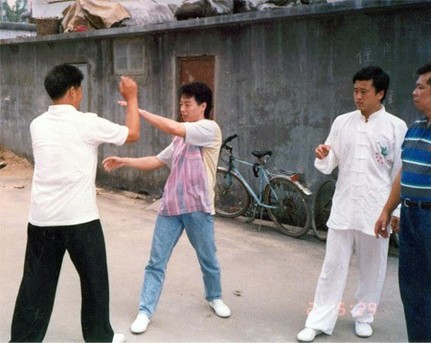 Yantai training
Yantai training
Did Zhong Shifu relate any particularly memorable tales about Lin Jingshan?
Hmm, a story that Shifu Zhong has told me that Lin Jingshan is a Christian (I can’t remember whether Roman Catholic or Protestant), and that Yu Hai’s father was also a Christian. That is why Yu Hai other name is Yu Tiantang, meaning Heaven.
Yes, he was a Catholic apparently. Possibly another reason he did not do so well during the Cultural Revolution.
Yes, I also think so.
I have heard a few of Lin’s sayings over the years and they are still very appropriate even today. Do you bear any such thoughts in your mind as you approach your training and do you share such things with your students?
The mostly famous saying of Lin Jingshan is “Still to learn” - meaning we still have to learn. No matter how great you are, you still have to learn. That saying is definitely true. I learn many things, I even sometimes learn from my students. That’s why we continue our martial art path.
Despite transitioning to Lin Jingshan’s lineage (which has no lion dancing tradition) you have retained the lion dance methods that I believe you obtained at Ling Nam. Precisely what style of lion do you practice and teach? You also work the dragon as well right? Where did that come from?
I do lion dance and well as dragon dance. Lion dance I learned at Ling Nam, then Ling Nam once invited Choy Li Fut master Poon Wai Ying from Hong Kong to teach us additional dance steps. Then later the grandson of Luk Chi Fu, a good friend of mine Joe Luk, also shared techniques with me. I teach the traditional and modern style of lion dance. Fuzhou dragon dance I learned from Singaporean dragon instructor Ting Wan Kee. Shifu Ting Wan Kee was the lineage holder of Wu Mei Pai.
Hmm, a story that Shifu Zhong has told me that Lin Jingshan is a Christian (I can’t remember whether Roman Catholic or Protestant), and that Yu Hai’s father was also a Christian. That is why Yu Hai other name is Yu Tiantang, meaning Heaven.
Yes, he was a Catholic apparently. Possibly another reason he did not do so well during the Cultural Revolution.
Yes, I also think so.
I have heard a few of Lin’s sayings over the years and they are still very appropriate even today. Do you bear any such thoughts in your mind as you approach your training and do you share such things with your students?
The mostly famous saying of Lin Jingshan is “Still to learn” - meaning we still have to learn. No matter how great you are, you still have to learn. That saying is definitely true. I learn many things, I even sometimes learn from my students. That’s why we continue our martial art path.
Despite transitioning to Lin Jingshan’s lineage (which has no lion dancing tradition) you have retained the lion dance methods that I believe you obtained at Ling Nam. Precisely what style of lion do you practice and teach? You also work the dragon as well right? Where did that come from?
I do lion dance and well as dragon dance. Lion dance I learned at Ling Nam, then Ling Nam once invited Choy Li Fut master Poon Wai Ying from Hong Kong to teach us additional dance steps. Then later the grandson of Luk Chi Fu, a good friend of mine Joe Luk, also shared techniques with me. I teach the traditional and modern style of lion dance. Fuzhou dragon dance I learned from Singaporean dragon instructor Ting Wan Kee. Shifu Ting Wan Kee was the lineage holder of Wu Mei Pai.
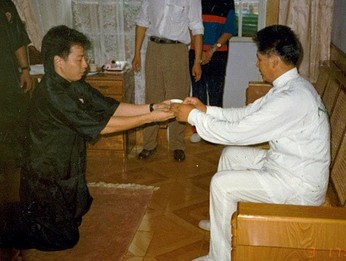 Baishi 1993
Baishi 1993
What level of interest do Chinese martial arts such as Tanglang generate in a country with such a rich and largely combat effective indigenous martial tradition? Is Kungfu viewed as the poor cousin of Eskrima, Kali and Silat? Is Kuntao perhaps viewed more favourably due to its more local flavour?
Tanglang is not yet very widespread. Many people still don’t know it yet, only the kind of mantis in the movie Kung Fu Panda.
Yeah, thanks for that DreamWorks (at least he wasn’t as soft as the mantis in ‘A Bug’s Life’)...
This year we have gained permission from Zhong Lianbao to officially establish the International Qixing Tanglang Kung Fu Federation Philippines. We will be the sole Philippines representative to oversee the development of Shifu Zhong Lianbao’s Tanglang here. We will also be the body in charge of producing qualified instructors, so we will be the one to propagate it.
There has never really been a link between Kung Fu and Eskrima or Silat. These local indigenous styles can be found at the southern part of the Philippines, like Visayas and Mindanao. The early Chinese immigrants from Fujian and Guangdong settled mostly in Manila and nearby provinces in Luzon. Kuntao is a local martial art style, which is derived from Chinese martial art. The word Kuntao is a Fujian word for Fist.
Is there any history of fighting between the Chinese and indigenous styles?
I’ve never heard of it.
Damn! I was hoping for some stories of epic battles to the death (with the Chinese styles conquering of course).
Tanglang is not yet very widespread. Many people still don’t know it yet, only the kind of mantis in the movie Kung Fu Panda.
Yeah, thanks for that DreamWorks (at least he wasn’t as soft as the mantis in ‘A Bug’s Life’)...
This year we have gained permission from Zhong Lianbao to officially establish the International Qixing Tanglang Kung Fu Federation Philippines. We will be the sole Philippines representative to oversee the development of Shifu Zhong Lianbao’s Tanglang here. We will also be the body in charge of producing qualified instructors, so we will be the one to propagate it.
There has never really been a link between Kung Fu and Eskrima or Silat. These local indigenous styles can be found at the southern part of the Philippines, like Visayas and Mindanao. The early Chinese immigrants from Fujian and Guangdong settled mostly in Manila and nearby provinces in Luzon. Kuntao is a local martial art style, which is derived from Chinese martial art. The word Kuntao is a Fujian word for Fist.
Is there any history of fighting between the Chinese and indigenous styles?
I’ve never heard of it.
Damn! I was hoping for some stories of epic battles to the death (with the Chinese styles conquering of course).
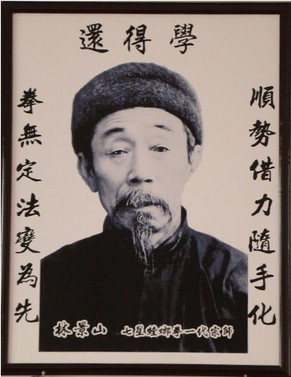 Portrait of Lin Jingshan including his motto regarding the need to continue learning
Portrait of Lin Jingshan including his motto regarding the need to continue learning
What are the techniques that you know you can generally rely on in actual combat?
Basically I am a good kicker, I love to kick. When I started studying from shifu Zhong, I began developing my hand techniques. My favourite techniques are Quan Chui (Circle Punch) and Yu Huan Ding Xin Chui (Jade Ring Against the Heart Punch).
I have heard that like most Shandong masters, your Shifu was fond of a brawl every now and then in his younger days (and who wasn’t?) Everyone loves a good fight story, so are there any he has related that you would care to share?
Sorry I never asked him, and he never bragged about the fights he had. His nephews are pretty tough guys. I heard stories about them fighting with other schools.
Basically I am a good kicker, I love to kick. When I started studying from shifu Zhong, I began developing my hand techniques. My favourite techniques are Quan Chui (Circle Punch) and Yu Huan Ding Xin Chui (Jade Ring Against the Heart Punch).
I have heard that like most Shandong masters, your Shifu was fond of a brawl every now and then in his younger days (and who wasn’t?) Everyone loves a good fight story, so are there any he has related that you would care to share?
Sorry I never asked him, and he never bragged about the fights he had. His nephews are pretty tough guys. I heard stories about them fighting with other schools.
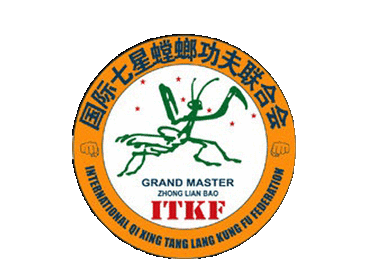
Please share with us your most beloved training methods, taolu and weapons. Are there any that you may not have had the chance to study but would love to pick up?
I like forearm striking and pai da gong. My favourite taolu are Tou Tao Quan (Steal the Peach) and Jie Chui (Intercepting). For weapons, I love the straight sword - Tanglang Jian. Maybe I would like to study Chuan Yun Jian.
Lastly, how important has it been to you to be able to pass on the martial arts to your own children. Are you worried about the tradition continuing beyond your own life?
I am happy that my son loves martial arts. I always tried to bring him along whenever I had Wushu or lion dance exhibitions when he was young. I started training him when he was six years old, now he’s doing Qixing Tanglang, lion and dragon dance, but his girlfriend is taking much of his time now ha ha… I think he can be very good if he trains harder. There are some of my students that teach outside the association, I permit them as long as they are qualified and they have an approval from me. I hope that they will continue my work.
Maybe you can pay your son’s girlfriend to go on a long vacation? Ha ha...
Seriously though, it must be a great feeling to see it continuing under its own steam. There’s nothing better than when your students actually want to go out and spread the art (instead of being forced to).
Thank you very much for talking with me and sharing some of your valuable experience with our readers. Thanks also for your brotherhood in years gone past. I really appreciated knowing that I had family not so far away in the Pacific.
Are there any final remarks?
I am happy to be able to tell you about my Wushu past. I want to thank all the teachers who taught me in the past; especially Shifu Zhong Lianbao who I consider my father, to Shimu who has continued to support me and to my family, disciples and students, who give me strength to continue to teach, thank you very much.
Cheers mate. It’s been a pleasure.
I like forearm striking and pai da gong. My favourite taolu are Tou Tao Quan (Steal the Peach) and Jie Chui (Intercepting). For weapons, I love the straight sword - Tanglang Jian. Maybe I would like to study Chuan Yun Jian.
Lastly, how important has it been to you to be able to pass on the martial arts to your own children. Are you worried about the tradition continuing beyond your own life?
I am happy that my son loves martial arts. I always tried to bring him along whenever I had Wushu or lion dance exhibitions when he was young. I started training him when he was six years old, now he’s doing Qixing Tanglang, lion and dragon dance, but his girlfriend is taking much of his time now ha ha… I think he can be very good if he trains harder. There are some of my students that teach outside the association, I permit them as long as they are qualified and they have an approval from me. I hope that they will continue my work.
Maybe you can pay your son’s girlfriend to go on a long vacation? Ha ha...
Seriously though, it must be a great feeling to see it continuing under its own steam. There’s nothing better than when your students actually want to go out and spread the art (instead of being forced to).
Thank you very much for talking with me and sharing some of your valuable experience with our readers. Thanks also for your brotherhood in years gone past. I really appreciated knowing that I had family not so far away in the Pacific.
Are there any final remarks?
I am happy to be able to tell you about my Wushu past. I want to thank all the teachers who taught me in the past; especially Shifu Zhong Lianbao who I consider my father, to Shimu who has continued to support me and to my family, disciples and students, who give me strength to continue to teach, thank you very much.
Cheers mate. It’s been a pleasure.
